M. Isidora Forrest's Blog, page 18
September 11, 2022
The Mysterious “Water Crypts” of Isis
 A Ptolemaic queen with Isis Knot, brought up from the waters at Alexandria
A Ptolemaic queen with Isis Knot, brought up from the waters at AlexandriaYou already know how important water and symbols related to water were in the ancient worship of Isis. As Iset-Sopdet, Her stellar rising signaled the rising waters of the all-important Inundation throughout Egypt. Her beloved Osiris could be considered to be the Waters that She called forth. And as we said a couple weeks ago, one of Isis’ many, many epithets is Mother of Waters.
Due to its importance in Egypt, water became an important symbol of the Goddess as Her worship spread outside of Egypt, too.
 Serapis and Isis from Pompeii temple, note the Goddess in the boat between Them
Serapis and Isis from Pompeii temple, note the Goddess in the boat between ThemWe know of several Mediterranean temples that had what archeologists refer to as “water crypts,” though this was not a common feature. In fact, out of the 63 known Isis-Serapis temples in the region, only six of them have these water crypts. So they were special; and also somewhat mysterious since we don’t know exactly how they were used in the temple rituals. (Yet, I’m sure, both you and I could come up with some likely conjectures about that.) But first, let me tell you a little bit about some of the ones they’ve found, then we can let our imaginations run wild.
 From temple of Isis Pompeii, priest carrying a sacred object with veiled hands
From temple of Isis Pompeii, priest carrying a sacred object with veiled handsAll of the water crypts are underground. They are in chambers either under the temple itself of under the courtyard of the temple and were accessible by descending stairways. There are no windows or light shafts, so they were in total darkness and must have been illuminated by torches or lamps. All of them contained a water basin, either larger or smaller, that was connected to a water source—a channel from a river, a canal, or piping for rain water. None have drains, so, if they were ever empty, they would have been emptied by hand. They found a jug that could have been used for such a purpose in the crypt at the Pompeii Isis temple.
 The stolisterion at the Pompeii Isis temple; the water crypt is beneath this small structure.
The stolisterion at the Pompeii Isis temple; the water crypt is beneath this small structure.Another feature is that these crypts were not open to the public. They were, instead, behind lockable doors, presumably accessible only to temple personnel.
At Pompeii, there is a small building over the crypt that is decorated with images of people in a procession and in prayer, so it seems clear that the water was considered sacred. It is most likely that the water was intended to be “Nile water” even though its source was not the Nile. Following in that tradition, Isis Magic includes a rite for making your own magical Nile water for use in your rites.
Natural Nile water was also, at times, imported for rites in Isis and Serapis temples outside of Egypt. The Roman satirist Juvenal makes fun of Roman matrons who he says would crawl on their knees to Egypt to fetch water with which to sprinkle Isis’ temple.
 Fresco from Pompeii temple, making offerings before image of Osiris?
Fresco from Pompeii temple, making offerings before image of Osiris?Some researchers have theorized that the crypts were related to Egyptian nilometers, structures in the temples used to measure the height of the Inundation, but no measuring marks have been found in the water crypts, so that is unlikely. Others have wondered whether the crypts might have been used to simulate a mini Nile flood in the temple, but they don’t seem to contain any kind of apparatus that would accommodate such a use. (On the other hand, the Egyptophile Roman Emperor Hadrian had just such a “Nile flood” built into his villa near Tivoli. The “flood” was water that poured out from beneath a huge bust of Isis-Sothis and filled a long canal in the villa that simulated a branch of the Nile called the Canopus.)
 The monumental head of Isis-Sothis-Demeter from Hadians Villa, now in the Vatican Museum
The monumental head of Isis-Sothis-Demeter from Hadians Villa, now in the Vatican MuseumIt seems more likely that the water crypts were simply used to supply the sacred water used in the temple rites. The waters of the Nile/magical Nile might be used to purify the temple and the sacred images and other cult symbols and ritual tools.
We know that water was used as a sacred symbol in and of itself. Surely it was also used in offering rites. But I wonder if temple personnel were allowed to drink it under any circumstances? Clearly, it would have been a privilege.
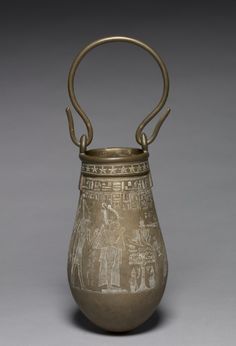 An Egyptian situla or washeb
An Egyptian situla or washebWe do know that a vessel filled with such sacred water was presented by priests with veiled hands during some of the rites, such as the ceremonies to open the temple in the morning and in processions.
There were a number of types of vessels associated with Isis’ worship, which makes sense given the clear emphasis on the sacredness of water. Perhaps the most common was the situla, a word that comes from Latin for bucket or pail. The Egyptian situla, washeb in Egyptian, was a ceremonial vessel used to make offerings of (usually) water or milk. Situlae were usually made of metal—bronze, silver, or even gold.
Egyptian examples were often heavily decorated with hieroglyphs and scenes involving fertility, nourishment, or the cult of the Deity. Frequently, they appear to have been illustrated with scenes that involved either nurturing, such as images of the Cow Goddess, or fertility and sexuality, such as images of the plump Nile God, the Child God on a lotus, or the ithyphallic God Min.
 Roman priestesses and priests of Isis, the urnula is carried by priestesses on left and right, situlae by priests in center
Roman priestesses and priests of Isis, the urnula is carried by priestesses on left and right, situlae by priests in centerSome situlae were rounder and somewhat breast-shaped, some elongated and reminiscent of a closed lotus bud. Usually, they did not have flat bottoms and so would have had to hang from the handle on a hook or other support. Situlae evoked the magic of renewal and regeneration both through their decoration and the fluid that they contained.
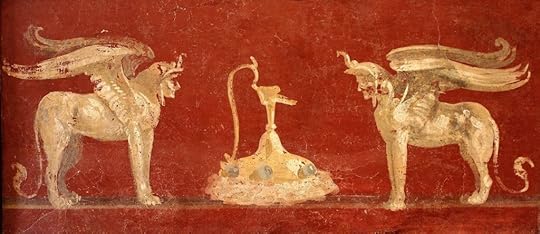 From the Pompeii temple, sphinxes guarding an urnula
From the Pompeii temple, sphinxes guarding an urnula Apuleius’ tale of initiation into the Mysteries of Isis includes a description of a procession for Isis in which a vessel often known as an urnula was carried. Apuleius described it in detail in his account of the procession. He says it represented highest Deity, but was not in the form of any animal nor any human, yet that it inspired wonder in those who beheld it because of its strangeness.
 Osiris Hydreios
Osiris HydreiosThis sacred Isian object was a small vase of gold with a rounded body, its base adorned with Egyptian figures (possibly hieroglyphs). It had a long spout on one side and on the other a graceful, curved handle. A rearing Egyptian cobra often decorated the handle. This type of vessel would seem ideal for pouring libations.
If we conceive of the combination of Isis and Osiris as highest Deity, we might see the vessel as Isis Who contains Osiris, the God Who is the sacred water itself. Apuleius doesn’t explain further, so we are left to speculate.
 Isis and Serapis as serpents with Osiris Hydreios between Them
Isis and Serapis as serpents with Osiris Hydreios between ThemAnother, rather strange, “vessel” associated with temples of Isis in the later period is known as the Osiris Hydreios, or Osiris of the Waters. These images seem to have originated around the first century BCE and are mainly associated with Isis sanctuaries in northern Egypt (Alexandria and its suburbs) and southern Italy (Rome and environs).
The images of Osiris Hydreios resemble Egyptian canopic jars, the jars that contained the internal organs of mummies. They are decorated with Egyptian motifs and crowned with the head of Osiris. Sometimes, however, the head of Isis or Anubis replaces that of Osiris. Earlier in this post, I put quotes around the word vessel because—though the images are shaped like vessels, and they relate to a watery aspect of Osiris—they were not hollowed out and therefore could not have actually contained water.
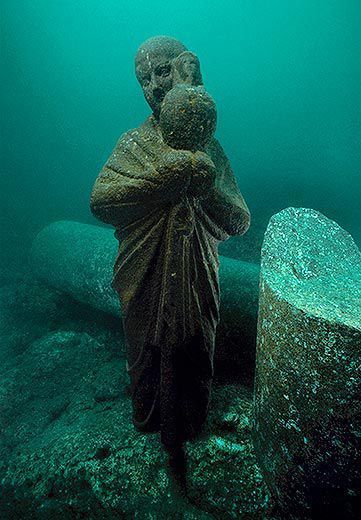 A priest of Isis carries an Osiris Hydreios in veiled hands
A priest of Isis carries an Osiris Hydreios in veiled handsIsis and Her Beloved Osiris have long, long been associated with the life-giving Waters. Living as the ancient Egyptians did in that narrow strip of the Black Land that received the blessing of water, they knew in their bodies and souls the vital importance of water.
Here in the west, at the end of summer, with fires and smoke raging around us, we too can know—deep in our bodies and souls—the vital sacredness of water.
September 4, 2022
Isis & the Magic of Acacia
 Birds in an acacia tree, from a Middle Kingdom tomb
Birds in an acacia tree, from a Middle Kingdom tombHere in the Pacific Northwest, we are finally experiencing some rather lovely Labor Day weather.
Yesterday, our community rehearsed for the Fall Equinox Festival. (“The Descent of Inanna.” Oh my. If you are in the area, do come. It will be magic and Mystery.) Today, we go to find early September’s peaches and tomatoes from local farms. Those may be my two most favorite things to eat…with Oregon blackberries close behind. And those luscious, prickly darlings grow wild here.
So for today’s entry, I am feeling a bit laid back. Let us then explore one of Isis’ many symbols and affinities. This time, something growing, something wild, something not native to Oregon…but which is native to Egypt: the acacia.
There are many species of acacia, medium-sized, thorny trees with rough, dark bark that can be found in the arid parts of Africa and Asia.
In parts of Africa, the trees characteristically have a dome-shaped canopy because of the way the giraffes graze them. Yet the acacia has developed what seems like an almost miraculous defense system. The tree senses its leaves being grazed. This triggers the release into the acacia’s leaves of a poisonous tannin—so poisonous, if enough is consumed, it can even be deadly.
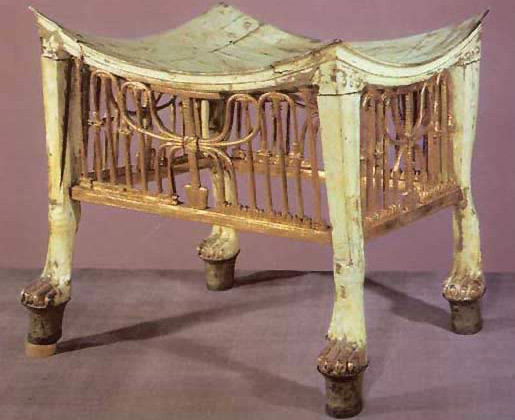 A stool made from acacia wood
A stool made from acacia woodResearchers discovered this when they observed giraffes browsing only one in ten acacia trees, while antelopes on a fenced game ranch that could not roam freely ate acacia and died. Furthermore, the tree emits a chemical, ethylene, into the air that can travel on the breeze about 50 feet to alert nearby acacia trees—and they produce the tannin, too.
While the ancient Egyptians may not have been aware of the less observable aspects of this cycle, they clearly recognized acacia as special—both practically and magically.
On the practical side, the Egyptian acacia, acacia nilotica, has many, many uses. Acacia, called shont, shonnet, shondj, or shondet in Egyptian (it is called sont in modern Arabic), is an attractive hardwood from which the ancient Egyptians built, among other things, boats, sarcophagai, and furniture.
… the Boat of Ra arrived at the town of Het-Aha; its forepart was made of palm wood, and the hind part was made of acacia wood; thus the palm tree and the acacia tree have been sacred trees from that day to this.
The Legend of Horus of Behutet and the Winged Dis
Acacia’s sweet smelling, yellow flowers, which look like little yellow sunbursts, are astringent and were used to help cleanse the skin and clear up skin problems. Brewed acacia leaves were drunk in a cough mixture. They were also applied to wounds and swollen limbs for their astringent properties. The tree’s seedpods are edible by livestock. The crushed bark produces tannin that was used to help heal burns and tan leather.
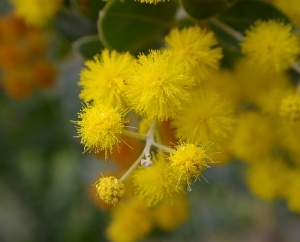 Acacia flowers are sweet smelling and look like mini suns
Acacia flowers are sweet smelling and look like mini sunsGum acacia (aka “gum arabic”), a resin exuded by the tree, has an amazing variety of uses. It is edible and is extremely nutritious. During the gum harvest, modern-day pickers are said to live almost entirely on it, and just six ounces is enough to sustain an adult for a day.
Gum acacia assists in blending and smoothing fats, so it is often used in candy making. It can be used in medicines, incense, paint, and even as glue. Ancient Egyptian women used gum acacia, blended into a base of dates and honey, as a contraceptive. And it worked, too. When gum acacia is dissolved, it produces lactic acid, a spermacide.
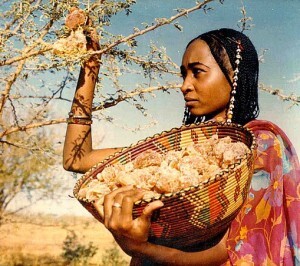 Woman gathering gum acacia in Sudan
Woman gathering gum acacia in SudanDMT, a hallucinogen associated with spiritual experiences, may be present in acacia nilotica in low doses. It is, however, present in other species of acacia in higher doses. This has, of course, led some to speculate that the Egyptians may have used the drug as a way to contact the Otherworld.
And that thought is the perfect crossover to look into acacia’s magical potentcies.
The acacia could represent both life and death for it was thought to encompass both. As the antelopes learned, the tree can be deadly, though it is more often connected with life and healing. The tree is evergreen, making it an apt tree of life. Its yellow flowers look like small suns, making it a solar and renewing, tree. Among the virtues of acacia recorded by Pliny, is a quality that would seem to associate it with resurrection and renewal:
…but the principal merit that it possesses is, that when it is cut down, it will grow again within three years.
Pliny, Natural History, Book XIII, chapter 19
 Acacia pods, very nutritious, make excellent fodder for all kinds of animals
Acacia pods, very nutritious, make excellent fodder for all kinds of animalsIn one of the formulae of the Coffin Texts, wood from the Goddess Saosis’ (that is, Iusaaset, the primordial Grandmother of Creation and the Gods, sometimes identified with Hathor or Isis) sacred acacia is crushed by the deceased for its healing properties.
In another, the acacia provides an unidentified instrument of power that enables the deceased to avoid evil things in the Otherworld. In yet another text, the acacia appears to be an ingredient in a divine mortar.
The acacia is also associated with the Double Lion, the twin lions Who guard the horizon to the Otherworld.
The Egyptians must have considered the acacia an ancient, even primordial, tree. In the Book of Coming Forth by Day, the deceased says that he stands before Anubis in a time before the acacia was born, that is, In The Beginning, before the Deities had established All Things. At Heliopolis, there was a tradition that all the Goddesses and Gods were born beneath an acacia tree. In the Book of Coming Forth by Day, the deceased goes to “the Acacia Tree of the Children;” probably the Divine Children of Iusaaset, the Goddesses and Gods born beneath the sacred acacia.
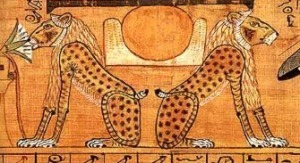 Just as the Double Lions served as the gateway to the Otherworld, sometimes Two Acacia Trees could be a gateway
Just as the Double Lions served as the gateway to the Otherworld, sometimes Two Acacia Trees could be a gatewayWhile the acacia is associated with a number of Egyptian Deities, it has specific associations with Isis and Her family. A particular acacia—simply called The Acacia, or Shondj—was sacred to Her. The Goddess Shontet, the Acacia Goddess Who took part in the Osirian resurrection rites at Djedu (Mendes), was considered to be a form of Isis. Isis and Nephthys together were called the Two Shonti Goddesses, that is, the Two Acacia Goddesses.
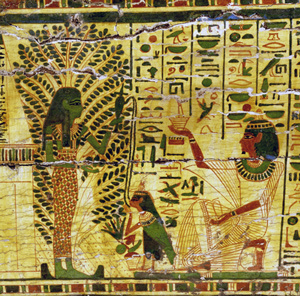 The deceased makes offering while his ba receives water from the Acacia Goddess in the Otherworld
The deceased makes offering while his ba receives water from the Acacia Goddess in the OtherworldIn the story of the “Contendings of Horus and Set,” Isis, in the form of Her sacred bird, flies into the branches of Her holy acacia after tricking Set into condemning His own attempts to usurp the rightful rule of Horus, Isis’ son. In some tales, the acacia is the tree that magically grew up around the body of Osiris when His sarcophagus washed up on the shores of Byblos. He is called “the One in the Tree” and “the Solitary One in the Acacia.” In the Pyramid Texts, Horus, “comes forth from the acacia tree.”
In one of the poison-curing spells that include the legend of “Isis & the Seven Scorpions,” when Horus is stung and cries out in pain, it is the doorkeepers at the Temple of the Holy Acacia Tree who hear Him and send a cry to the heavens for help, since Isis is away making libations for Osiris.
 Acacia nilotica, showing leaves and thorns
Acacia nilotica, showing leaves and thornsBecause of Divine associations like these, acacia could serve as an offering to both Horus and Isis—and although I haven’t run across it yet, it would seem that acacia would be a very appropriate offering for Osiris as well.
The acacia is a tree of beauty, usefulness, powerful protection, life and death, and the magic of healing…and thus it is sacred unto Isis, Iset Shontet, the Lady of the Acacia.
August 28, 2022
Isis, the One & the Many More
Part 2
 And now we know how a black hole sings
And now we know how a black hole singsLast time we looked at several of the many ways human beings have envisioned the Divine Reality and how each may be of value in our always-developing relationship with Isis.
As we start today, let’s also keep in mind that people will always have issues with the way just about any of these theisms is defined as well as who should be defined into or out of any given group. As we said last time, one’s conception of Divine Reality remains a touchy subject; it should be approached with kindness and curiosity.
It is not my intent to propose any all-inclusive definitions, nor to sort anyone into any box, whether that box is hard-edged or more flexible. In fact, it may be just the opposite. I hope we can explore our relationship/s with Isis through a wide variety of theistic lenses. Each of them may have something to teach us about how humans have imagined the Divine Reality and, as we try them on, we can decide for ourselves which ones are the best fit—or the best fit right now.
 Isis as Creatrix by Jeszika Le Vye; you can buy a copy at the link
Isis as Creatrix by Jeszika Le Vye; you can buy a copy at the linkIsis & Polytheism
First up today, polytheism. Easy, right? A belief in many Deities. But in recent years—less so now (I think) than five or so years ago—modern polytheists have been discussing types of polytheism, which are usually referred to as hard or soft polytheism.
“Hard” and “soft” polytheism?
In simplest terms, hard polytheism refers to the concept that many Deities, Who are separate and real Beings and Who have their own agency (that is, the ability to take action as They desire), exist.
Soft polytheism’s definition is, as you might expect, a bit more complicated and can be an umbrella for a number of different ways of looking at the Divine Reality. One of those ways is that the world’s Deities are all expressions of one Deity or a core pantheon of Deities. Dion Fortune’s famous axiom: “All the Gods are One God, all the Goddesses are One Goddess, and there is One Initiator” is an example of this concept. Or we might consider that the Deities are personifications of natural forces (sun and moon, for example). Or that the Deities are psychological or archetypal (for example, Jungian archetypes). Some modern Pagans distinguish this last type of polytheism as naturalistic and eschew any kind of metaphysics in their view.
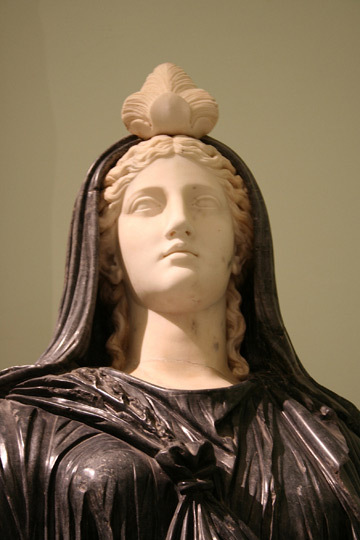 Roman Isis, from the 2nd century CE, in the Farnese Collection in Naples
Roman Isis, from the 2nd century CE, in the Farnese Collection in NaplesAll of these expressions of polytheism are relatively easy to use as a framework for at least a part of our relationship with Isis. As a unique Divine Being with Her own agency, personality, and concerns, we can make offerings to Isis of Her favorite things. We can pray for help with Her traditional concerns. We can meditate on Her many powers as they have come down to us from ancient myth and historical research. As She is the Goddess of Magic, we can work magic with Her help. It’s likely that this is the way many of us connect with Her on a day-to-day basis, whether or not we conceive of Her as a discrete Goddess or as part of an underlying unity.
If we take a “soft” perspective, we might see Isis as many of Her ancient worshipers did, as the Goddess of Ten Thousand Names, She Who is Isis and Neith and Aphrodite and Hera and Hekate and so many more. Or, if She is a personification of a natural force, which one? Heka? Sun? Sirius? Wind? (She’s such an all-encompassing Goddess, it’s difficult to choose just one; but, of course, we don’t have to.) If we consider that She is all of them, what does that tell us about Her Nature and Being? Or, if She’s an archetype, which one or ones? Mother? Magician? Trickster? Healer? Ruler?
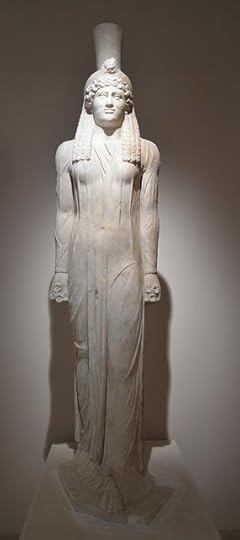 Statue of Isis from the Greek sanctuary at Brexiza, about 160 CE
Statue of Isis from the Greek sanctuary at Brexiza, about 160 CEYet this far from concludes our polytheistic options.
Henotheism, kathenotheism, monalatry & Isis
A henotheistic conception of the Divine holds that while there are many Deities, we focus on one without rejecting the others. It was first coined in the 1700s and originally used to describe the so-called “primitive monotheism” of the ancient Greeks. A number of modern scholars use it for the syncretism of Late Antiquity in the Mediterranean—with the worship of Isis being the prime example.
Henotheism may also include the idea that all Deities are united through one Divine Essence; this approach is thus related to a kind of monism, which is why some scholars prefer the term monalatrism to henotheism. Another type of henotheism is kathenotheism, in which one worships “one God at a time.” This may be my own most common personal practice. While I am devoted to Isis and to Dionysos, and I have some kind of a…thing…with Raphael, I don’t work with all of Them together, but rather one at a time.
It has been my experience that many modern Isiacs relate to Isis through some form of henotheism, at least sometimes. Employing this view, we learn that we can have a primary Deity or Deities without rejecting other Divine Ones. It allows us to be good guests in the temples of Deities Who are not our primaries, yet we still know Them as the true Divinities They are.
Isis & Pantheism/Panentheism
Pantheism is the idea that unified Divinity is completely immanent in the created universe. All-That-Is is God/dess. Generally, pantheists don’t posit a personal Divinity, though they attribute Divine qualities, such as eternity and ineffability, to the All-That-Is. There is quite a bit of philosophical/theological discussion about what-all this means. (I refer you to the Stanford Encyclopedia of Philosophy for that.)
But I’m trying to simplify. Pantheism might be another case where we could say, “Isis is All Things and All Things are Isis.” In this case, everything is not just OF Her (as Source), but IS Her. How would we relate to our world if we could keep that conception in the front of our minds? How does the act of making offering—or any ritual for that matter—change? Does Deep Mystery become Deep Science?
 Her blood the Waters, Her body the Earth, art by Cristina McAllister; you can buy a copy at the link
Her blood the Waters, Her body the Earth, art by Cristina McAllister; you can buy a copy at the linkPanentheism takes this a step further. Divinity is immanent in the universe, but It also extends beyond both time and space and is transcendent in relation to the universe. Like pantheism, panentheism is a relatively new word, being coined in 1828. Neoplatonism, some Hindu sects, some South and North American indigenous religions, as well as some sects of Judaism and Kabbalah, Islam, and Christianity have some panentheistic elements.
We can also point to such elements in post-Amarna Egyptian theology. One of the hymns to Amun-Re hails Him as “the one Who makes Himself into millions, Whose length and breadth are limitless.” Egyptologist Erik Hornung, in discussing this hymn, understands “oneness” as the condition of the God before Creation and “millions” as the polytheistic Divine Reality after Creation. Egyptologist Jan Assman (mentioned in relation to his “Mosaic distinction” last week) explains that Amun-Re, as the One Who makes Himself into millions and yet remains within, behind, and encircling the multiplicity He has created, gives us a panentheistic Deity Who is within the Creation, but also prior to and containing it.
We have already met Isis in an All-Goddess capacity in some of our monotheistic and monistic discussions. And while I’m sure philosophers and theologians can discuss the complexities and distinctions, again, I am trying to simplify. What both of these views may do is bring Isis closer to our world. It is easy to see Her in the natural world as river or mountain (“Her blood is the water, Her body the earth”), but is She also [in?] the laptop I’m typing on? For me, there is an intimacy in this conception that feels personal, whether pantheistically, we reject the idea of a personal Deity, or panentheistically, we accept it.
Animism & Isis
Some philosophers and theologians see the beginnings of pantheism in animism. Animism is an ancient worldview in which all things, from Deities to humans to plants, animals, and rocks, all have their own spiritual essence/soul/spirit. Everything is alive in some way; everything is spiritual. Generally, these essences are distinct—so we can interact with the plant people or an individual tree for example. There may or may not be an underlying unity. There is ongoing discussion as to whether animism is a religion or a worldview.
 Ka statue of King Hor with the ka symbol on his headdress
Ka statue of King Hor with the ka symbol on his headdressIt is easy to see animist harmonies with the ancient Egyptian concept of the ka, the vital essence in all things (and to some extent, the ba; but let’s just stay with ka for now). Ka is the difference between life and death. It can be given, transferred, and received. We can interact with it in the beings around us. It connects us to our ancestors and even back to original Creation, the Zep Tepi or First Occasion. While each being and thing has its own ka, there is an underlying relationship between all kas due to their origin in First Creation, so here we have an underlying connection if not unity between all things.
In this view, Isis has a Divine ka—or many kas since She is a tremendously powerful Deity. We may seek to learn about and to experience Her ka in meditation. When making offering, it is the ka of the offering that is transferred to the ka of Isis in order to receive its nourishment or other benefits.
I have been working on becoming more conscious of the ka in all things as I move through my life. It definitely takes practice, what with all of life’s mundanities, but it is also a fulfilling way to re-enchant the world.
Autotheism & Isis
The last type of theism I’ll address is autotheism. It’s a new term to me, but it’s an old concept, and one that fits quite well with ancient Egypt. The Wikipedia definition is fairly straightforward: “the viewpoint that divinity, whether also external or not, is inherently within oneself and that one has the ability to become godlike.” (You’ll also see it defined as the worship of oneself, but that’s not what we’re talking about here.)
 The fiery heart of the divine within
The fiery heart of the divine withinIn the early days of my involvement in the local Pagan community, part of the Circle was often to greet each other with “Thou art Goddess.” It drove me slightly crazy because it seemed like a treacly platitude. But I was wrong. This autotheistic concept is what was intended: recognizing that there is Divinity in me and in you and in all of us. In Isis Magic I have called this Divine Within the Isis Heart—the Iset Ib—which is our deep and Divine connection to Her.
I’m going to leave aside the question of whether or not humans can become godlike while alive (in some circumstances, yes; but it bears more discussion than we can do here). Instead, let’s head back to ancient Egypt and Isis.
As many of you already know, the pharaoh was considered a living Deity—at least when acting in specific capacities. Pharaoh was also deified in death. For most other Egyptians (at least the ones for whom we have records), becoming godlike was an after-death experience. With proper rites and having lived a life of ma’et, one could become an akh, an effective or transfigured spirit. Akhs could be effective on earth; the famous “letters to the dead” were likely addressed to the person as akh. And, being a godlike akh, they could dwell among the Deities in the otherworld.
The spiritual Work of discovering and nurturing our own divine natures is growth ably guided by the hand of Isis. As we develop our relationship with Isis, we will also deepen our human nature and discover our divine nature. It is easy to understand being the best human being we can be, but what does it mean to help our divine nature blossom? How is that different from our best human nature? Or is it?
Harmonies and paradoxes
 Looking into Her heart
Looking into Her heartThinking through the different views of Divine Reality humans have envisioned is a worthy meditation for today’s devotees of Isis. For if we look back to the traditions of ancient Isiacism to instruct or inspire our modern devotion at all, then we will inevitably find ourselves confronted with holy puzzles that might slot into one or another of these various ways of looking at Our Goddess and the Divine Reality.
As we meditate on these puzzles, we may come to discover our own answers…at least our answers for now. Personal answers to questions like these can change over time as we discover, experience, and learn more about ourselves and about our relationship with Her.
August 21, 2022
Isis, the One & the Many
 What is the Divine Reality?
What is the Divine Reality?Shall we talk about a subject that can be a tad touchy?
It can be touchy because discussing it can make us uncomfortable for it bears on the whole question of what our concept of the structure of the Divine universe is. We human beings tend to get quite invested in how we see, or how we were taught to see, what that Divine Reality is.
There are many different terms we’ve come up with to address the different ways of interpreting that reality. Monotheism, polytheism, atheism. Agnosticism, monism, henotheism, pantheism, panentheism, animism, autotheism. Some of these can be considered subdivisions of others, and then they might have their own subdivisions as well. It’s complicated.
 AI-created Goddess Isis from my prompt
AI-created Goddess Isis from my promptWith the exceptions of atheism and agnosticism (believing there are no deities or that we simply cannot know whether there are), most of the world’s interpretations of Divine Reality—and our relationship with those interpretations—can have value for us in our own relationship with Isis.
Wait, what? Aren’t a lot of those concepts contradictory? Yes, they are. Or perhaps they are paradoxical. In the same way that light behaves as both a wave and a particle, perhaps the answer is “yes, and.” And isn’t it interesting that Light has often been used as a metaphor for Divine expression? For me, the Divine Reality is a universe of paradox. So, paradoxtheism?
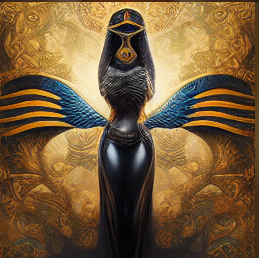 Another AI Isis; there is something here…Ta Wahet?
Another AI Isis; there is something here…Ta Wahet?Isis & Monotheism
In Egypt, She was called T3 w’t (Tah Uwah-et), “The Only One.” In Greek, this same epithet of the Goddess became Thiouis (Thee-oou-iss). The way some Romans expressed this concept may be summed up in a graffito found on one of the walls of the Temple of Isis in Rome: Una, quae es omnia, Dea Isis, “Being one, Thou art all, Goddess Isis.” While Isis is the Only One and the Unique One, so are other Deities. Re is the Only One and the Unique One, and so are Atum and Ptah and more. For me, this is a clue about the nature of Deities and Divine Reality—that each Deity, at some time, in some way, on some level, for some people, can be The Only One.
Egyptologist Jan Assman, in The Price of Monotheism, discusses what he calls “the Mosaic distinction,” the concept that my God is the One True God and every other Deity is a “false god” and he names the Egyptian pharaoh Akhenaton as its first known practitioner.
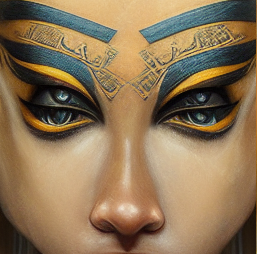 Strange and interesting Isis from the robot brain
Strange and interesting Isis from the robot brainAssman also makes the interesting observation that following Akhenaton’s “revolution,” as the old Deities were restored to worship, Akhenaton’s influence nevertheless continued to be felt as the idea of a Hidden Deity Who existed behind and was expressed in all the other Deities came into prominence. He calls this development “evolutionary monotheism” and finds it in the later stages of polytheism not only in Egypt, but in Mesopotamia, Greece, and India as well. In Egypt, this was most notable in the worship of Amun-Re, the Hidden One Who is both the Creator outside of Creation and immanent in all things.
So, what can we learn if we relate to Isis in a monotheistic way?
This would be Isis as THE Goddess. And there IS only THE Goddess. I’ll admit this one is a bit hard for me; it’s been a long time since I broke the spell of monotheism in my own spiritual life. But as a thought experiment, then. How would we relate to Her if She were indeed the Only One? Would She even need a name? If this were the only Divine Reality, I think I might find myself inching over into panentheism. At the very least, such a thought experiment might give us a better understanding of some of our neighbors who do conceive that theirs is the only [true] Deity. Ah, but there’s the rub again isn’t it; “only true.”
 Creation from the primordial waters
Creation from the primordial watersIsis & Monism
Another expression is called monism and the idea here is that everything derives from One Source. There are varieties of monism, but singularity and unity are central. The Greek Neoplatonist Proclus likened it to the spring from which all rivers flow. The ancient Egyptian concept of the Nun, the Primordial Watery Abyss from Which All Things Arose, is very much in harmony with this idea. From undifferentiated no-thing-ness arose multiplicity and every-thing-ness.
What can we learn if we see Isis as as The Source? And in fact, one of Her epithets is Mother of Waters, referring not only to the yearly Inundation, but also to those primordial Waters.
For Offering to Isis, I imagined a new myth, inspired by this monistic conception of Isis as the One Source as well as my personal fascination with the four fundamental forces of nature: the strong nuclear force, the weak nuclear force, electromagnetism, and gravity. Here’s my story…
In the Time Before Time, there was only the No-Thing-Ness, the Divine Womb Waters of Isis Thiouis, the Only One. The Throne had not yet come into Being. There was No Existence. Nor was there any Becoming. And the Goddess and the No-Thing-Ness were One; and They were Not.
Then Thiouis conceived in Her Heart the desire to create. As Her Heart conceived, so Her tongue spoke the Words of Power, and immediately, the Throne—the Iset—came into Being, Full of Magic. From No-Thing came forth Some-Thing.
The Goddess made as the four sides of the Iset the Four Primordial Forces of Nature: Attraction, Flow, Disintegration, and Integration. She stretched out Her Great Wings and fanned Life into the Throne of Herself.
The Forces awakened, extending Themselves into the Universe, which was unfolding as They, too, unfolded. The Goddess fanned Her Wings again and All Things were in Chaos whirling, spiraling, and turning in Space. The stardust that contained the Seeds of Growth was scattered.
The Four Forces of the Iset did their work. They began the Awakening. They initiated the Movement. They embarked on the Changing. They entered into the Coming Together. Creative Chaos became Creative Order. The planets, solar systems, and galaxies coalesced.
And on the widespread planets, Integration drew to Herself the Seeds stirred up by the Wings of Isis. And the Seeds came together on the planets and the chain of evolution began in Fire and Water and Air and Earth. The Becoming had begun. And thus did the Goddess Isis birth the Being and the Becoming and All That Is by what She conceived in Her Heart and brought forth with Her tongue.
from ‘Throne’ in Offering to Isis
 The Goddess Source, generated by AI with part of the myth as prompt
The Goddess Source, generated by AI with part of the myth as promptIn this myth, while Isis is the One Source, the universe She brings forth is multiform, multi-reality, and multi-Divine. All Deities, all things, and all of us flow from Her spring. We are Her Children so that Isis is All Things and All Things are Isis.
And that’s just one story, one way of looking at the Divine Reality. These different ways of looking at the Divine Reality are just that: ways of looking at It. They might be true for the moment we are looking. They might be true, for us, forever. They might be true at exactly the same time another way of looking is also true. Paradoxtheism.
I didn’t think this post would get so long, so we’ll carry the rest over into next time. Then, we’ll look at the many and varied polytheisms, where Our Lady is very much at home, as well as a few other theisms.
August 14, 2022
Isis the Enchantress
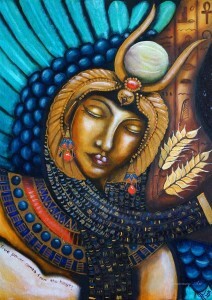 Golden Isis by Jane Marin. You can buy a copy here.
Golden Isis by Jane Marin. You can buy a copy here.Are you feeling enchanted these days? Disenchanted? A sense that things are alive and bright? A sense that they are flat and dull?
When the practicalities of life take up all of our attention, it is hard to feel the Mystery. We might feel disconnected from the magic, the wonder, the deep beauty of life—as well as the veiled expressions of mysterious Reality that lie beyond and interpenetrating it. Some have called this sense a disenchantment of the world and have fervently wished for a re-enchantment.
This heart-cry for re-enchantment is not new. We human beings have long complained about the world’s disenchantment. German sociologist Max Weber famously decried it in the early 1900s and before him Freidrich Schiller in the early 1800s. No doubt the discussion goes back much farther than that, too.
 The disenchanted Max Weber
The disenchanted Max WeberI first read the term in the work of Thomas Moore, a psychotherapist, former monk, and spiritual writer. His books, Care of the Soul and The Re-Enchantment of Everyday Life, were best sellers, which tells us that there are many of us longing to bring the enchantment back. As steps toward re-enchantment, Moore calls us to get away from our self-centeredness and experience the Other, to relinquish some of our literalism to become more poetic, to get out in nature, and to seek out Mystery. I have found these to be are recommendations, indeed.
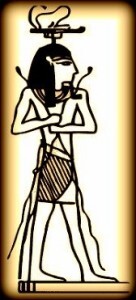 The God Heka, “Magic”
The God Heka, “Magic”The enchantment of everything—the magic in everything, the magic OF everything—is one of the things I most admire about [probably my personal fantasy of] ancient Egypt, as least as far as we understand it. I love Jeremy Nadler’s interpretation in his book, Temple of the Cosmos, when he writes about the “interpenetrating worlds” of the ancient Egyptians. Spiritual realities are immediate and present because the spiritual world interpenetrates the earthly: “for the ancient Egyptian, a metaphysical world poured into the physical, saturating it with meaning.” Yes. Yes. YES!
My own quest for enchantment is one reason why I describe my spiritual path as the Path of Sacred Magic. In practice, this encompasses everything from simply chanting for Isis to a wide range of the expressions of modern Hermeticism (which indeed has its oldest roots in ancient Egypt), including the theurgic rites of magic that are intended to grow our souls and spirits. Of course it also explains, at least in part, my attraction to Isis, Great of Magic.
You have probably also seen Isis described by the lovely title, “the Great Enchantress.” Who else would be the Goddess of Re-Enchanting the World but the Great Enchantress Herself? Yet when we see the title in older English translations, “Isis the Great Enchantress” usually translates Iset Werethekau, which we have discussed here. The translation as “enchantress” seems to have been preferred by some of the Old Gentlemen of Egyptology who were perhaps a bit uncomfortable with the squirmy idea of magic and wanted a kinder and gentler epithet for the admirable Goddess Isis.
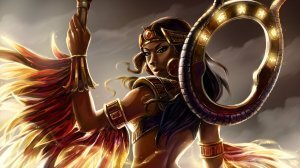 A badass magic-wielding Isis inspired by the game Smite; this piece is by KalaSketch
A badass magic-wielding Isis inspired by the game Smite; this piece is by KalaSketchBut enchantment has a long magical history. It comes from the idea that acts of magic are often sung or chanted or accompanied by singing or chanting. To be enchanted is to be affected by the magic carried in the chant or song. About 1300 CE, the word enchantment came into English from Old French, which got it from Latin incantare, “to sing into.”
Isis the Great Enchantress often activates Her magic by voice. The “Hymn to Osiris” in the Book of Coming Forth by Day says of Isis:
She recited formulæ with the magical power of her mouth, being skilled of tongue and never halting for a word, being perfect in command and word, Isis the Magician avenged her brother.
A papyrus in the Louvre says:
Isis. . .who repels the deeds of the enchanters by the spells of her mouth.
And a healing formula in the collection of the magical papyri says the spell will be successful
…according to the voice of Isis, the magician, the lady of magic, who bewitches everything, who is never bewitched in her name of Isis, the magician.”
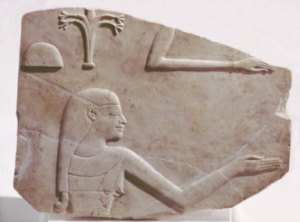 The Goddess Merit
The Goddess MeritIn the second example above, Professor Robert Ritner, who has studied Egyptian magic and its vocabulary extensively, translated the Egyptian word shed-kheru as “enchanters.” “Shed” means “to enchant” and “kheru” is “coming/going forth” as in peret kheru, an invocation offering, the “going forth of the voice.” Shed-kheru then is something like “those who send forth enchantments by voice.” Shed seems to have been a specialized form of “to recite” and was used both in magical formulae and in temple ritual texts. When the Creatrix Goddess Neith spoke the cosmos into existence, She shed, “recited,” Her akhu, “spells.”
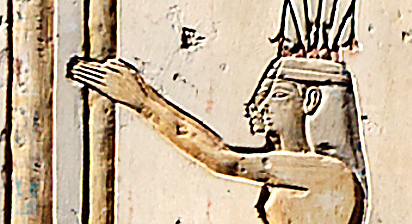 The Mereti, a dual form of Merit, one for upper and one for lower Egypt
The Mereti, a dual form of Merit, one for upper and one for lower EgyptEspecially on His healing cippi, Horus is sometimes called Horus-Shed, “Horus the Enchanter.” And yes, you are way ahead of me again. Of course, Isis, too, is called The Enchanter. In Her case (feminized), it is Iset ta Shetyet. In fact, we have a handful of instances of that name being applied to Isis. And so it seems that Isis is indeed The Enchantress and I shall have to retract my previous snark at the Old Gentlemen.
Chanting, singing, and music were a vital part of the worship of the ancient Egyptian Deities. By the time of the New Kingdom, the most common sacred title for women was Chantress or Singer of the Deity. These priestesses served both Goddesses and Gods, providing the songs and music that raised and channeled the energy of the sacred rites.
 Meret from the temple of Seti I; image by Heidi Kontkanen
Meret from the temple of Seti I; image by Heidi KontkanenThe Divine archetype behind this ritual role was the Goddess Merit or Meret, Whose name means “The Beloved.” With Her song, music, and magical gestures, Merit took part in the Creation. Daily, Her song greets the dawn and in kingship rites Merit encourages the king to bring good things to his kingdom, commanding him to, “Come, bring!” In this role of speaker and singer, Merit and the priestesses who represented Her—and in some cases, bore Her name as a title—were called “Great of Praise.”
This was not meant to indicate that the priestess herself was praiseworthy (though she may have been). Instead, it meant that her praise—that is, the hymns she sang and the words she spoke—were words that had effect in the Divine realms. Just as the words of Isis, the Lady of Words of Power, are ritually efficacious, so the words of Merit are ritually efficacious.
Much of the magic of the ancient Egyptians was focused on the idea of renewal, rebirth, and reconnecting to the perfection of the First Time. For ourselves today, perhaps we should add to those three “r”s, a fourth: re-enchantment. As we work to renew and restore the world around us, it may be that our inner work is to renew our own magical perception of the world, re-enchanting ourselves from the inside out. And I’m quite sure that a chanted incantation to Isis the Enchantress wouldn’t hurt either.
August 7, 2022
Who was Isis before She was Isis?
Back in 1962, an English archeologist named Peter Ucko wrote a landmark work entitled The Interpretation of Anthropomorphic Figurines. It challenged the idea that all these mainly-female figurines that many of us are fond of as ancient Goddess images are Goddess images at all.
Instead, he saw them as toys or concubine grave images or pregnancy talismans or sex instruction tools or…you get the picture: just about anything except Goddess images.
 Beak-faced figurine with upraised arms and bent at the waist; predynastic Egyptian, now in the British Museum
Beak-faced figurine with upraised arms and bent at the waist; predynastic Egyptian, now in the British MuseumPre-Ucko, many archeologists interpreted the figurines as Divine beings, possibly as images of an overarching Great Mother (we do so love our monotheism). Post-Ucko, that theory was largely abandoned, perhaps with some relief in certain quarters, as too simplistic. But then researchers like Marija Gimbutas and Elaine Eisler revived the Great Mother theory in the ‘80s and ‘90s and helped spark the most recent incarnation of the Goddess movement.
Today’s post is inspired by the work of Dr. Joan Relke of the University of New England (Australia), who takes a new look at these ancient figurines, particularly the ones from predynastic Egypt…and one in particular that is near and dear to my heart, and perhaps to yours, too.
 Male figure with upraised arms, perhaps in a ka-like gesture; predynastic Egyptian, now in the Metropolitan Museum of Art, NY
Male figure with upraised arms, perhaps in a ka-like gesture; predynastic Egyptian, now in the Metropolitan Museum of Art, NYThere are almost 250 of these images from ancient Egypt. Most of them were found in Upper Egypt, that is, southern Egypt. Only two of the extant images are from Lower Egypt, that is, the well-rivered Delta, where clay images buried in wet earth might not fare so well. Most of the images were recovered from graves. Most are female, though some have animal features, such as the famous bird-beaked “dancing woman.” Most are made of baked clay, though there are examples made of ivory, stone, and unbaked clay as well. Generally, they are thought to date to the Naqada period (4,000-3,500 BCE).
Much of Ucko’s conclusions about the non-Divinity of the images was based on his idea that a Deity ought to look impressive—have a headdress, be found in a sacred area, or be made of costly materials. (Though graves qualify as sacred areas, the Egyptian images were found in non-elite graves, which probably entirely explains why they were made of clay. Even today, householders in India will make small Divine figurines of clay to use in their home rituals. I make some of mine with modern clay—that stuff you can cure in the oven.)
 Beak-faced female with upraised arms; predynastic Egyptian; now in the Brooklyn Museum of Art
Beak-faced female with upraised arms; predynastic Egyptian; now in the Brooklyn Museum of ArtBecause these predynastic images were almost entirely found in graves, it is likely that they had a specifically mortuary purpose. And, of course, dynastic Egyptians continued to make specifically mortuary goods—including Divine images. If these figurines were indeed Deity images, as I think they are, perhaps they were intended to represent early versions of some of the most prominent of the dynastic mortuary Divinities: Hathor, Nuet, Isis, Nephthys, Anubis, and Osiris.
Now we come to the figurine near and dear to my heart. She is one that I’ve even made a copy of for myself: the bird-beaked dancing woman. There are 38 examples of this type of figurine: beaked face, up-raised arms, hands curved, legs together or conjoined in a “peg.” Some of these figures also bend over at the waist or are perhaps intended to be sitting. Some of the figurines appear to be pregnant. And there are two examples of a male figure with raised arms and a beaked face (see above), but only one with an arm posture like the female figurines.
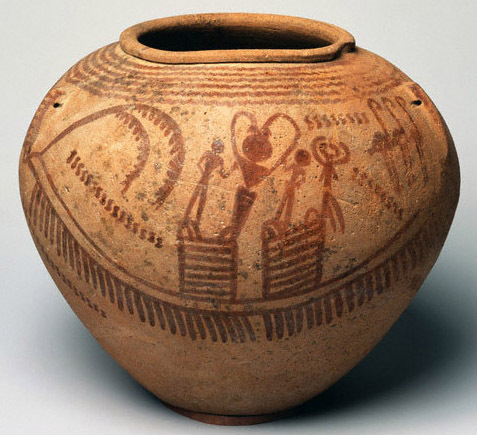 Jar with female figure with upraised arms; predynastic Egyptian, now in Brooklyn Museum of Art
Jar with female figure with upraised arms; predynastic Egyptian, now in Brooklyn Museum of ArtThe raised-arms posture is ancient. The earliest Nile dwellers drew female figures with upraised arms on pots and cave walls. Relke reminds us that upraised arms continued to be important in the dynastic period in the form of the hieroglyph of the ka. It’s not the same posture. The women’s upraised hands curve inward; the ka glyph’s palms face front. The ka glyph is, however, similar to the raised arms on the male raised-arm figurine above.
We also see raised arms in images of Nuet on the interior of the coffins, where She stretches Her heavenly body out over the deceased. Relke offers a very interesting possibility for the position of the seated or bending over figurines. She thinks it could be that the figure is intended to be curved over the body of the deceased, as is Nuet on many coffins.
 Dinka man with cattle; isn’t this a wonderful image?
Dinka man with cattle; isn’t this a wonderful image?Or the upraised arms might be the horns of a Cow Goddess—Hathor or Bat. The modern Sudanese Dinka people are famous for their cattle culture. There is a specific dance where the women upraise their arms in imitation of cow horns, and youth undergoing initiation care for a cow and at times upraise their arms in imitation of her horns. Hathor is, of course, one of the most ancient Egyptian Deities and Her association with the cow may be traced all the way back to Naqada (4,000 – 3,500 BCE).
 Women dancing with arms in a horn-like gesture; from tomb of Kheruef, Theban necropolis
Women dancing with arms in a horn-like gesture; from tomb of Kheruef, Theban necropolisWe also see upraised arms in images of Isis, Nephthys, and Their mother Nuet as They protect the deceased in tomb and sarcophagus. Their upraised arms are bird-winged. In the figure of the dancing woman, her bird-beaked face is an extremely prominent feature, in fact, it is the only clearly animal feature of the figure. It must have been important. And while Nuet doesn’t have a bird-form, both Isis and Nephthys do. Relke further comments that the dancing woman’s sharply beaked face is strongly reminiscent of the beak of a predatory bird—like the kite hawk form of Isis and Nephthys. Relke (and this is one reason I am enjoying her work so much) finds it strange that Egyptologists haven’t connected the bird-beaked woman found in so many graves with the mourning bird-formed Goddesses Isis and Nephthys, Whose images are also found in graves and tombs. Well, yeah.
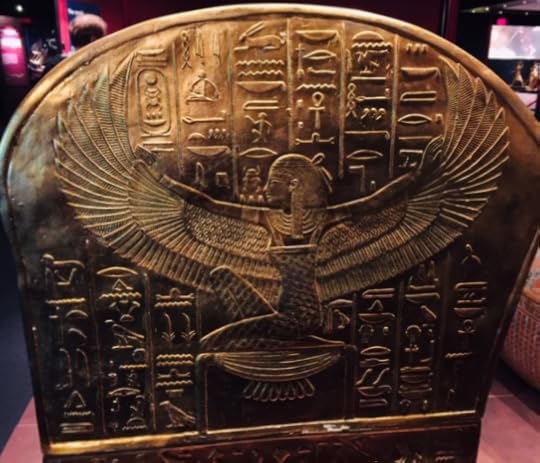 Isis with upraised wings; from the foot of one of Tutankhamon’s golden caskets
Isis with upraised wings; from the foot of one of Tutankhamon’s golden casketsAnd in fact, Relke thinks the prototype for the bird-beaked female figurines with upraised arms is none other than…yes…Our Lady Isis.
We can certainly argue the point, but as you might guess, I’m all-in on this one. I have long said that Isis, or proto-Isis, is an ancient, ancient, ancient Goddess. She is the Death Bringer (for She is a raptor) and She is the Resurrector (for She is Great of Magic).
 My own “dancing woman,” made from oven-baked clay
My own “dancing woman,” made from oven-baked clayHere’s why Relke thinks Isis might be the best candidate for the Divine Being represented by the mortuary figurines:
With upraised arms/wings and slightly bent posture, the Goddess is hovering over the deceased as we see images of Isis hovering over Osiris’ phallus preparatory to conceiving Horus. She suggests that the ancient Egyptians could see the sweep of the arms as both wings and horns and notes that the fingers of some of the dancing women are detailed so that they resemble feathers—and, of course, Isis is both a Bird Goddess and a Cow Goddess. The fact that some figures appear to be pregnant may allude to the new life of Horus/the deceased that Isis carries in Her belly. She suggests that dynastic culture brought the important Goddess Isis forward from predynastic times, making Her more royal and more firmly associating Her with the throne—even naming Her the Goddess Throne. Even so, Isis always maintained Her intimate ties with the everyday people—as savior, as healer, as protector, as mother—just as She had with all those ordinary people in whose graves the image of the Bird Goddess, hovering, protecting, and bringing forth new life were found.
Relke concludes that while there is certainly reason to consider other Goddesses as represented by the figurines,
Of the Dynastic deities, Isis possesses the greatest number of qualities that can be assigned with confidence to the symbolically rich Predynastic figurines. She is occasionally associated with a cow when she adopts Hathor’s crown and as Sopdet in cow form. As well, the implications for equating the vitality of the Ka with the vitality of cattle, and the suggestion of the Ka in the raised arms comply with Isis’s role as instigator of fecundity, both in the Underworld and the agricultural world. The hawk symbolism, the hovering body form and the implications of pregnancy in the afterlife bring this group of figurines in line with Isis’s role in the revivification of the deceased.
“The Predynastic Dancing Egyptian Figurine,” Joan Relke, Journal of Religion in Africa, Vol. 41, Fasc. 4 (2011), pp. 396-426.
So does the famous Bird Goddess figurine represent proto-Isis? As you can imagine, I certainly like that idea…through we may never have enough information to be sure.
 Love this pot…women, flamingos, and a Goddess!
Love this pot…women, flamingos, and a Goddess!
July 31, 2022
Nubian Isis
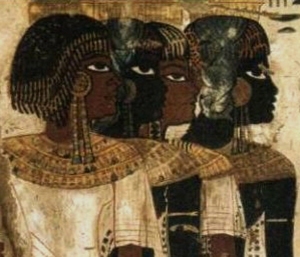 The Ethiopians, Africans, and Egyptians know Me by My true name of Queen Isis.
The Ethiopians, Africans, and Egyptians know Me by My true name of Queen Isis.Lucius is—still—an ass.
He had been messin’ where he shouldna been messin’, and he had been turned, quite literally (or perhaps literarily), into a donkey.
The ancient writer Apuleius’ story about Lucius, called The Golden Ass, culminates in Lucius’ initiation into the Mysteries of Isis. It is She Who saves him from his asinine state. But before that, we find Lucius addressing desperate prayers to the Goddess in the moon. He is answered by an epiphany of Isis, Who gives an aretalogy describing Her powers and names. In part of it, She says,
But the Ethiopians who are illuminated by the first rays of the Sun God as He is born every day, together with the Africans and the Egyptians who excel through having the original doctrine, honor Me with My distinctive rites and give Me My true name of Queen Isis.
Apuleius, Metamorphoses Book XI, 5; capitalization mine
By Apuleius’ time, Isis was deeply into Her Myrionymous phase as Lady of the Ten Thousand Names. Yet even then, he knows that the Ethiopians, Africans, and Egyptians are the ones who best know Her proper rites and Her true name of Isis. Isis has a deep and abiding relationship with those who know Her in this ancient and authentic way.
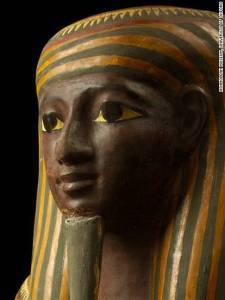 The coffin lid of 25th dynasty Theban Priest, Djeddjehutyiuefankh
The coffin lid of 25th dynasty Theban Priest, DjeddjehutyiuefankhSo for today’s post, I’d like to tell you something about Isis as She was known in the lands to the south of ancient Egypt, often known as Nubia. The name Nubia comes from an Egyptian term for “gold,” nub. Thus Nubia is the Gold Land. Nubia is (roughly) the ancient kingdom of Kush, with its famous capital city of Meroe, while Ethiopia, to the south and east of Nubia, may be what the Egyptians referred to as the Land of Punt. Today, Nubia is part of southern Egypt and Sudan and some of the people there still refer to themselves as Nubians.
You may also recall that in the last days of Philae, it was Nubian peoples such as the Blemmyes and Nobade who continued Isis’ worship at Philae even after the temple was officially closed. In Classical Greece, Kush was called Ethiopia, so in many texts any distinction between Nubians and Ethiopians is unclear. In this post, I’ll use Nubia and Nubian as general terms for the land and peoples to the immediate south of ancient Egypt.
 I cannot find the artist of this beautiful Isis…anybody know?
I cannot find the artist of this beautiful Isis…anybody know?Ancient Egypt and Nubia have a complex and interweaving history, at various times dominating and influencing each other. (Egypt’s 25th dynasty was a Nubian one.) During all this co-mingling, some Egyptian Deities came to Nubia, Isis among them. Probably established in Nubia around 1950 BCE (when Egypt was dominant and Nubian royalty adopted much Egyptian custom), Isis has long been a Nubian Goddess.
Isis was known throughout Nubia as The Great Lady of Nubia. In the British Museum, there is an Egyptian healing text in which Isis specifically says of Herself, “I am the Nubian and I have descended from heaven.” The formula is for the cure of poisoning. In the formula, Nubian Isis speaks a spell consisting of a long list of Deities Who come to bring healing to the sufferer. As the Nubian Who descends from heaven, She brings the healing of the heavens, of fertility, and of magic. Lana Troy, in Patterns of Queenship in Ancient Egyptian Myth & History, suggests that Isis’ Nubian blackness counteracts the painful redness of the poison.
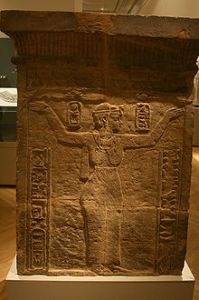 The Kandake, Queen Amanitore
The Kandake, Queen AmanitoreDiodorus Siculus preserves a Nubian tradition that the Egyptians were actually colonists sent out by Nubia (he says Ethiopia) under the leadership of Osiris. According to this tradition, what was then Egypt was, at the beginning of the world, only sea. It was the silt flowing north down the Nile that formed the land of Egypt. The tradition also says that Egyptian customs and writing are Nubian as well. (Diodorus Siculus, Book 3, section 3) Indeed, archeological investigations reveal this area as one of the world’s oldest civilizations, alongside Mesopotamia and Egypt. In Meroe, they used both hieroglyphs and Meroitic writing, which has been only partially decoded.
We find evidence of Isis throughout Nubia, but most strongly in the great city of Meroe and in Wad ben Naqa. Both are cities on the Nile; Wad ben Naqa is about 70 kilometers upstream from Meroe. We also find a strong presence of Nubians at Isis’ great temple at Philae, which became a place of pilgrimage for Nubians during the 25th dynasty when Nubians ruled in Egypt.
From Wad ben Naqa we have a pedestal of King Natakamani and Queen Amanitore that has both Meroitic script and hieroglyphs and which has helped enable the deciphering of Merotic thus far. The inscription addresses Isis:
Stay, stay on the great throne, Isis, Mistress of the Underworld, like the living sun-disk in the horizon, in that You let your son Natakamani remain on his throne. Stay, stay on the great throne, Isis, Mistress of the Underworld, as does the moon that grows like an egg in traversing heaven. May it give life to Your daughter, Amanitore.
It was said that Nubian kings ruled with the Queen Mother, called the Kandake, so Amanitore may have been Natakamani’s mother rather than his wife.
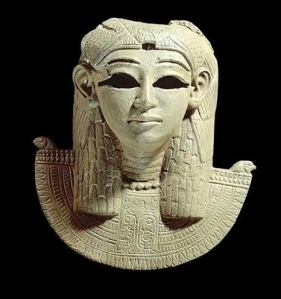 A Nubian aegis of Isis, from about 300 BCE
A Nubian aegis of Isis, from about 300 BCEIsis was important especially in Nubian funerary customs and in the kingship. Kings are frequently said to be the Son of Isis or Beloved of Isis. Some inscriptions indicate that it was Isis Who watched over the post mortum transformations of the deceased and eventually gave the Ka (Kha in Meroitic) permission to leave the tomb and go to the Otherworld. Isis was paired with Osiris in relation to funerary customs, in which Osiris served an Anubis-like function as Otherworld guide.
This inscription on a statue now in the Berlin Museum comes from the Nubian city of Napata and gives us some ideas about the powers of Nubian Isis. (Please note that I have removed the parentheses that the translator inserted to indicate implied words to make it easier to read):
Give noble renewal, O Isis, to the new vivification. Give renewal, give its erection. Reflect on the patron [that is, the person who dedicated the statue] and guide good prosperity on the good path indeed. Desire patron [I presume this means the patron desires] the bestowal of a rebirth to resound in Henel. Goodness comes into being as an Object of Respect for the patron. Give existence to the new vivification. Go now and give it leave. Fashion wonderment and order, O Isis, you will commence to make wonderment in abundance. The good Supporter even goes to wipe out much non-existence. The hero to behold all. Act now to bear approbation. You give guidance and nourishment. This is done by transmigration; give its existence. The disciple indeed to reflect on Isis the good, she puts on you guidance.
Isis leads. She commences to arrange your transmigration. Arrange now the gifts. The patron of Isis is to be exalted, like new. Spread the bequeathal of the hero in a pile. Rise to arrange and guide us to honor, O Isis. Much praise goes forth, Isis is to also bring authorization for the new vivification. The new vivification to give birth to the Kha anew in truth and dignity. The patron has permission to realize it. Isis is to make it happen…
In addition to worshiping the Goddess in their own land, Nubians traveled to Philae to honor Isis at Her great temple there as well. We know them from the “adoration graffiti” or proskynema they left at the temple and the surrounding area. (Read more about that sacred graffiti here.) Philae is at what was the borderland between Egypt and Nubia. Interestingly, the temple faces south, towards Nubia, which is not the usual temple orientation in Egypt. Excavations have found Nubian-like pottery at Philae, predating the temple there. The earliest certain evidence of Nubians at Philae is from about 690 BCE, during the 25th dynasty.
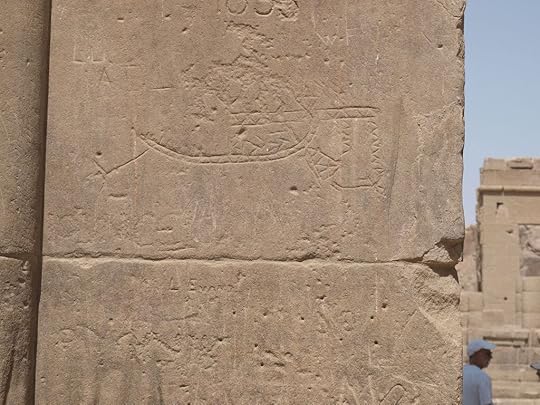 Graffiti at Philae
Graffiti at PhilaeThe Nubians who visited Philae were priests and “agents” of Isis and seemed to have timed their visits to coincide with the Festival of Osiris during Khoiak, which marked His death and renewal as well as the recession of the Nile flood and the time of sowing crops, and the Festival of Entry. They often brought donations of gold and other valuables for the temple there. One interesting inscription says that the envoy was to give ten talents of gold to the Philae priests and their daughters. I wonder if this meant that the daughters were serving as priestesses of Isis?
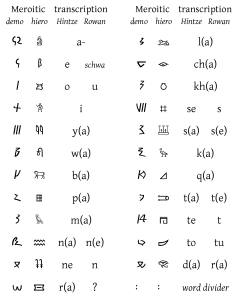 Merotic script
Merotic scriptThe Festival of Entry was the time when Isis journeyed to the nearby island of Biga with its Tomb of Osiris to pour milk libations for Him. During this time, the statue of Isis would be taken to Biga to preside over three ten-day Egyptian weeks of offerings. (A weekly version of this Festival took place at Philae, too, but apparently the big one was held once a year and that’s the one attended by the Nubians.)
A good deal of the Nubian graffiti at Philae attests to a personal relationship with Isis as a Goddess Who is disposed to helping the worshiper and Who “hears the petitions of those who are far off.”
Isis, the Great Lady of Nubia, brings Her healing from heaven, She watches over the transformations of the deceased and brings revivification, new life, and—as always, always—She welcomes a deeply personal relationship with Her devotees.
July 24, 2022
Isis in Petra
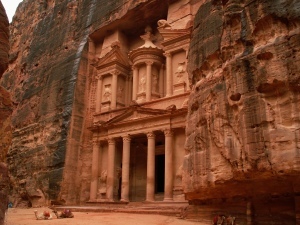 The “Treasury” (originally a mausoleum/crypt)
The “Treasury” (originally a mausoleum/crypt)Okay. Crazy week. I’m buried in some other projects today, so I hope you will enjoy this repost about the ancient city of Petra and how Isis was at home there, as She was in so many other places…
Who has not been astounded by the beautiful ghost city at Petra? Intricately carved from living, rose-hued rock, many of Petra’s ancient buildings have survived while their free-standing contemporaries have not.
Petra is in modern Jordan. It may have been established as early as the 3rd or 2nd century BCE and was the capital city of people known as Nabataeans. Petra—the name comes from the Greek word for “rock;” we do not know what the Nabataeans called it—was built into a rocky slope of a mountain and near a wadi, a valley that is dry except during the rainy season.
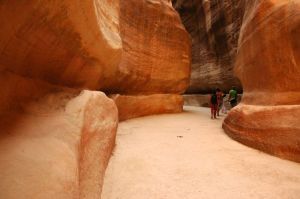 The “Siq” is the passageway by which modern visitors usually enter Petra
The “Siq” is the passageway by which modern visitors usually enter PetraNabataean architects and engineers are famous not only for the incredible buildings of Petra, but also for their brilliant control of the water supply. They were able to contain and store the waters of the flash floods to which the wadi was subject and to manage the flow of a small stream that was Petra’s sole ongoing water source. The work they did turned this desert city into an artificial oasis and enabled its caravan trade to flourish. Petra is one of the world’s most precious cultural sites, and like most of them, is threatened by both environmental conditions and tourism.
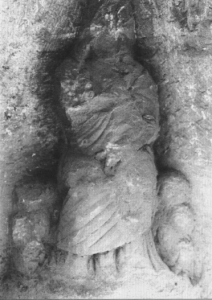 The Isis image from Wadi as-Siyyagh; without the inscription, “This Goddess is Isis,” we wouldn’t recognize Her
The Isis image from Wadi as-Siyyagh; without the inscription, “This Goddess is Isis,” we wouldn’t recognize HerAs you no doubt expect to hear by now, Isis was to be found in ancient Petra, just as She was throughout much of the Mediterranean world. She may have been brought there with Alexandrian craftsmen when they came to work at Petra, or by Nabataeans themselves who encountered Isis either in the Levant or in Egypt. We know of Nabataean settlements in the eastern Delta of Egypt.
The earliest date to which researchers are willing to commit for Isis’ arrival in Petra is 25 BCE. A sanctuary at Wadi as-Siyyagh on the outskirts of Petra includes an inscription that labels one of the rock-carved images there: “This Goddess is Isis.” The way the inscription is phrased and the ambivalent iconography of the image makes researchers think that Isis was being newly introduced to Petra at the time.
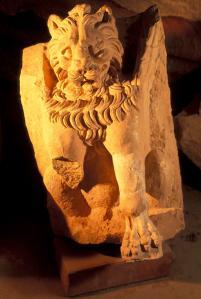 One of the winged lions from the Temple of the Winged Lions, photo by Richard Nowitz
One of the winged lions from the Temple of the Winged Lions, photo by Richard NowitzOn the other hand, the , to which we have referred many times, notes Isis as being called Savior “on the rock,” which may mean Petra. The aretalogy itself dates to the 2nd century CE, but its contents may go back to the 3rd or 2nd century BCE. Generally, scholars don’t accept this as solid enough evidence for Isis in Petra that early, nonetheless, it’s interesting.
Also interesting is that one of Isis’ most common aspects at Petra seems to have been Her mourning aspect. (Which, by the way, actually would accord quite well with Her Savior aspect; as the Mourner, She weeps for Osiris, but as the Savior, She weeps for us all.)
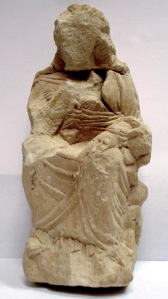 The Sorrowing Isis image found in the Temple of the Winged Lions
The Sorrowing Isis image found in the Temple of the Winged LionsWe know that She was honored in Petra in this aspect because of several Sorrowing Isis terracotta figurines found in what is known as The Temple of the Winged Lions, or “North Temple” if you want to be boring about it, as well as similar images found in other excavations throughout the area.
The most spectacular piece that was uncovered in the Temple of the Winged Lions is a rectangular stone with a female face on it inscribed ”Goddess of Hayyan son of Nypt.” Some have suggested that the headdress wreath once contained an Isis crown and thus have tried to say that the temple belonged to a syncretic Isis + Local Goddess, but I’m going to have to vote with the scholars who deny it on this one.
 The wonderful sacred image of Al-Uzza or Allat from the Temple of the Winged Lions
The wonderful sacred image of Al-Uzza or Allat from the Temple of the Winged LionsThe image is quite unlike any known for Isis and quite like many known for local Arab Goddesses. The wonderful image is most likely Al-Uzza, the matron Goddess of Petra, or perhaps just Allat, which means simply “Goddess” just as Allah means “God.”
Excavating a rubbish heap that covered older Petran homes, British archeologists found terracottas of Isis with Harpokrates dating at earliest to the 1st century CE. There is also an alabaster fragment of an Isis statue from ez-Zantur, another area in Petra, probably from about this same time. They have even uncovered a pottery workshop outside of Petra where they were making Isis images in addition to votive images for other Deities.
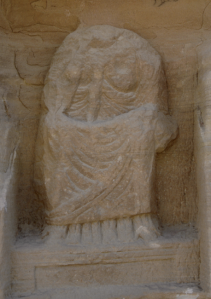 The Isis-knotted image from Wadi Abu Olleqa
The Isis-knotted image from Wadi Abu OlleqaThere is another Isis sanctuary at Wadi Abu Olleqa, again outside of Petra but on one of the main routes. There we can easily see the Isis knot on the now-headless image’s breast.
Important evidence of the influence of Isis in Petra comes from the fact that the Isis crown, known as the Basileion, was used on Nabataean coins from around 7 BCE. We also have records of several theophoric personal names from Petra: Abdisi and Thimisi; the “isi” in these names is “Isis.” (I’m afraid I don’t know what the other parts of the names mean. Can anybody help me out?)
 The Basileion of Isis on a coin with Cleopatra on the obverse
The Basileion of Isis on a coin with Cleopatra on the obverseSome have tried to connect the central figure on the famous Treasury, originally built as a mausoleum and crypt, to Isis. She seems to be a standard Tyche, the Luck of the City, with cornucopia in hand. Yet beneath Her feet is what does indeed look like it might be the horned headdress of the Cow Goddess (long associated with Isis by this time) with stalks of wheat flanking the horns and perhaps (I can’t make it out) the Amun feathers between the horns.
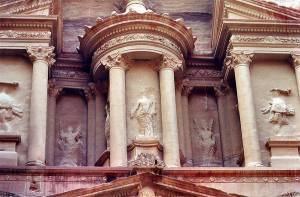 Isis-Tyche on the Petra Treasury (click the image to see it larger)
Isis-Tyche on the Petra Treasury (click the image to see it larger)So I’m willing to buy this figure as an Isityche, especially since the Basileion headdress of the Goddess has been found on Nabataean coins.
Since it was originally a mausoleum, perhaps Isis-Tyche was intended to bring luck and abundance in the afterlife.
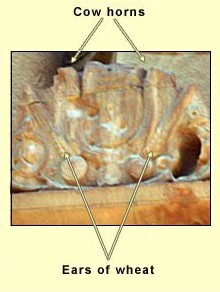 A close up of the “Isis crown” below the figure of Tyche
A close up of the “Isis crown” below the figure of TycheThe Sorrowing Isis images of Petra are nothing like the more ancient Egyptian images of Mourning Isis. Instead, they show a seated Isis, usually with the characteristic Isis knot in Her costume, in a posture of dejection. The image came into Petra, then was reproduced locally when it became popular.
Now, here’s the weird thing. According to Veit Vaelske, an archeologist at Berlin’s Humbolt University who has studied the Isis evidence at Petra, there seems to be no particular person or being for Whom Petra’s Sorrowing Isis sorrows. (Apparently no Osiris images have been found in relation to the Isis images.)
Vaelske seems rather amazed by that fact (exclamation points were used!) and thinks that this solitary Isis may be a particularly Nabataean form of the Goddess.
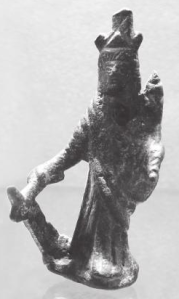 An Isis-Tyche from Petra
An Isis-Tyche from PetraI’m not sure that’s entirely justified. By this time, Isis’ worship was so thoroughly disseminated that any Isiac, and even non-devotees, would know exactly why She sorrowed. The Goddess’ image needn’t have been paired with a dead Osiris to communicate the extremely well known myth.
Or perhaps, as I mentioned before, this lone and mourning Isis could be intended to represent the Savior Goddess Who sorrows for all of us as we each pass through the tribulations of our own lives.
July 20, 2022
A First Fruits Offering for Isis

“My body being on Earth, my heart being awakened, my magic being in my mouth, O Isis, I make offering unto You.”
She always gets the first-bloomed lily from our garden. And today was the day. Added a bit of wild sweetpea and lavender for good measure.
July 17, 2022
Isis Invisible
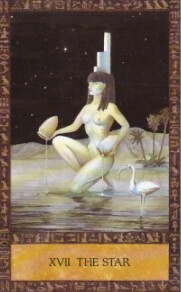 One of my favorite tarot images: Isis as The Star in the Ancient Egyptian Tarot by Clive Barrett
One of my favorite tarot images: Isis as The Star in the Ancient Egyptian Tarot by Clive BarrettIt is now full summer.
Some of us are burning. Having experienced it, it is terrifying. But this year, my home is blessed (so far) with much more moderate weather. And I am grateful.
It is at this time, in deep summer, that She is absent from the skies above me. And I long for Her, long for Her. As you may know, the reason that the star and ba-soul of Isis, Sirius, is gone from the skies is because—in the yearly rotation of the earth in the heavens—Sirius now appears close to the sun. As the sun rises, its greater light blocks the light of Sirius. So She is invisible to us now. But our Wandering Goddess will return.
But soon, She will rise before the sun and will be invisible no more. Here in Portland, Oregon in 2022, Sirius rises at 4:30 in the morning of August 23rd. Further south, She rises earlier. It all depends on your latitude. You can calculate Her rising in your area here with this online calculator. If you’d like to celebrate Isis’ birthday, then it would be two days before the rising of Sirius, in this case, August 21. So at least in my latitude, Isis is a Leo. And well, She is Isis-Sakhmet, and I believe at one time, She was among our wandering Lioness Goddesses, too.
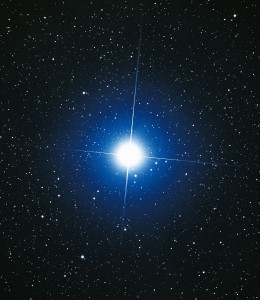 The Star of Isis, coming soon to a dawn near me
The Star of Isis, coming soon to a dawn near meLikely, you already know why Sirius was important to the ancient Egyptians, so I won’t repeat that here. But I would like to add a few interesting bits about Sirius in relation to the orientation of some Egyptian temples and shrines at the time of their construction. Some were oriented towards Sirius.
For instance, the small Isis temple at Denderah and Isis’ great temple at Philae seem to have been oriented toward the rising of Sirius. Philae may even have a double stellar orientation: one axis to the rising of Sirius, one to the setting of Canopus.
Overall, Egyptian temples have a variety of orientations. A survey in 2004 to 2008 actually went to all the temples in Egypt and measured the orientation. Genius, no? they showed that most temples were oriented so that the main doorway faced the Nile. But not only that. It seems that the temples were also oriented toward other astronomical events, most especially the winter solstice sunrise, which makes very good sense as a symbol of rebirth.
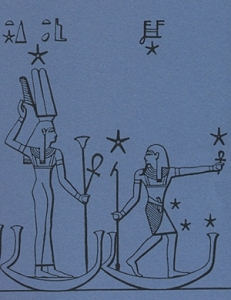 Iset-Sopdet following Sah-Osiris in Their celestial boats
Iset-Sopdet following Sah-Osiris in Their celestial boatsOrientation to Sirius is rarer and harder to be certain of since the earth’s position in relation to the stars has shifted over the millennia.
A Horus temple, called the “Nest of Horus” on the summit of the highest peak of the Hills of Thebes, seems to have been oriented to the heliacal rising of Sirius around 3000-2000 BCE. Nearby, an inscription carved in rock during the 17th dynasty (1580-1550 BCE) records the observation of just such a rising of Sirius. This high place would have been ideal for Horus in His nest to await the coming of His mother Isis. On the other hand, the archaeoastronomers who did the survey I mentioned believe that it may also be oriented to the winter solstice sunrise, an event closely associated with Horus.
Another temple that may have a Sirius orientation is the archaic temple of the Goddess Satet on the island of Elephantine. The original temple was built amidst the great boulders on the island and really is quite simply the coolest temple ever. It seems that when it was built (around 3200 BCE) the rising of Sirius and the rising of the winter solstice sun were at the same place—so it could have been built to accommodate both important astronomical events.
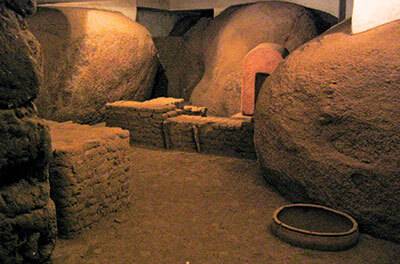 The original temple of Satet on Elephantine; made of mudbrick nestled among the natural boulders
The original temple of Satet on Elephantine; made of mudbrick nestled among the natural bouldersAfter the initial study, the same team followed up with a survey (in 2008) of some temples in the Fayum that they hadn’t been able to study before as well as temples in Kush. They found generally the same results except for the Nile orientation as many of these temples were built far away from the river.
They also made note of a son of a Priest of Isis, Wayekiye, son of Hornakhtyotef, who was “hont-priest of Sopdet and wab-priest of the ”five living stars” (the planets) and “chief magician of the King of Kush;” this according to an inscription on Isis’ temple at Philae dating to about 227 CE. (Many Kushites made pilgrimage to Philae and left devotional grafitti.) This inscription emphasizes the importance and sacrality of the study of celestial objects and events to the kingdom and it is quite interesting that this was the work of the Chief Magician. This 2008 study revealed that the largest number of Kushite temples and pyramids were oriented to either the winter solstice sunrise or the rise of Sirius.
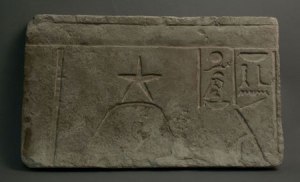 The star Sopdet over the head of the Goddess
The star Sopdet over the head of the GoddessAnother interesting thing the study found was that by the time of the New Kingdom, in the 34 temples that were unmistakably dedicated to a Goddess—usually Isis or a Goddess identified with Her—the most important celestial orientation point was the rising of Sirius. But, in addition to Sirius, the star Canopus was also a key orientation point. According to their data, Goddess temples in general were more frequently aligned with these very bright stars, Sirius and Canopus, while God temples were more often oriented to key solar-cycle events.
 On the horizon, She rises, with Orion/Osiris above
On the horizon, She rises, with Orion/Osiris aboveIf you are, like I am, feeling the anticipation of Her rising later this summer, you might like to do some ritual. The Opening of the Ways is always good. Use it as an invitation to Her. Or try a simple meditation, allowing yourself to yearn for Her coming. Waiting for Her and wanting Her is sometimes a very good exercise. You might set out a vessel of water (a shiny silver one is nice) on the night of Her rising, let it be charged with that rising energy in the dawn, then use it as part of your holy water for purification. I have just such star water that I use waiting in my shrine right now.



